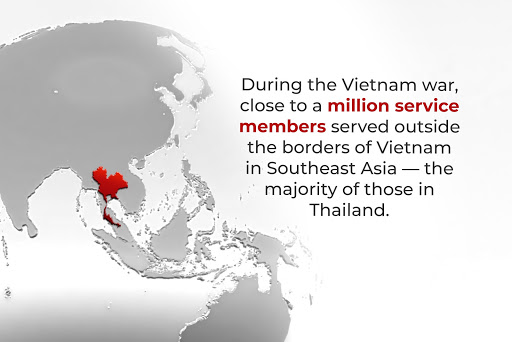Thailand Agent Orange Compensation Benefits for US Veterans
During the Vietnam war, close to a million service members served outside the borders of Vietnam in Southeast Asia — the majority of those in Thailand.
The United States Department of Veterans Affairs has conceded that Vietnam-era Veterans whose service involved active duty on or near the perimeters of U.S. military bases in Thailand anytime between February 28, 1961 and May 7, 1975 may have been exposed to herbicides and defoliants and qualify for VA disability benefits. You can learn about general Agent Orange benefits and Agent Orange’s history here.

A recently declassified Department of Defense report written in 1973 titled, “Project CHECO Southeast Asia Report: Base Defense in Thailand 1968-1972,” contains evidence that there was significant use of the herbicide Agent Orange along the fence-line perimeters of military bases in Thailand to remove foliage that provided cover for enemy forces.
The VA acknowledges the herbicides used on the Thailand military base perimeters may have been tactical and procured from Vietnam, “or a strong, commercial type resembling tactical herbicides.”
Which Veterans Are Eligible For Thailand Agent Orange Claims?
VA regulations state that Vietnam Era veterans whose service involved duty on or near the perimeters of military bases in Thailand anytime between February 28, 1961, and May 7, 1975, may qualify for VA benefits based on herbicide exposure.
Specifically, the VA stated that the following veterans may have been exposed to herbicides such as Agent Orange:
- U.S. Air Force Veterans who served on Royal Thai Air Force Bases (RTAF bases) at U-Tapao, Ubon, Nakhon Panom, Udorn, Takhli, Korat, and Don Muang, near the air base perimeter
- Army Veterans who provided perimeter security on RTAF bases in Thailand
- Army Veterans who were stationed on some small Army installations in Thailand (The VA requires the veteran to have been a member of a military police unit or assigned a military police occupational specialty whose duty placed them at or near the base perimeter).
To recap, the VA states that these veterans must have been near the air base perimeter anytime between February 28, 1961 and May 7, 1975; U.S. Army Veterans who provided perimeter security on RTAF bases in Thailand anytime between February 28, 1961 and May 7, 1975; and U.S. Army Veterans who were stationed on some small Army installations in Thailand anytime between February 28, 1961 and May 7, 1975.
However, the VA will only concede exposure for the Army Veteran IF he was a member of a military police (MP) unit or was assigned an MP military occupational specialty whose duty placed him at or near the base perimeter.
Which Disabilities Qualify for Agent Orange Claims?
Currently, the following conditions are presumed to be caused by Agent Orange and will receive presumptive service connection for qualifying veterans stationed in Thailand:
- AL Amyloidosis
- Chronic B-cell Leukemias
- Chloracne
- Diabetes Mellitus Type 2
- Hodgkin’s Disease
- Ischemic Heart Disease
- Multiple Myeloma
- Non-Hodgkin’s Lymphoma
- Parkinson’s Disease
- Peripheral Neuropathy, Early Onset
- Porphyria Cutanea Tarda
- Prostate Cancer
- Respiratory Cancers
- Soft Tissue Sarcomas
What Evidence Can Prove Your Case?
In 2010, the VA recognized that certain veterans who served on Thailand military bases now only have to prove the presence of a current disability and an in-service incident. This makes it much easier than before to prove your claim.
To prove an in-service incident with herbicide exposure, Thailand veterans must show on a factual basis that they were exposed during their service as shown by evidence of daily work duties, performance evaluation reports, or other credible evidence. Examples of credible evidence include:
- Military occupational specialty (MOS)
- Lay evidence (such as buddy statements) that the veteran’s work duties brought them on or near the perimeter.
- Lay evidence that the veteran’s recreational activities brought him on or near the perimeter, or took the veteran off the military base. Recreational activities such as softball or jogging often took place on the perimeters of some bases. Statements from the veteran and/or fellow service members who participated in recreational activities with the veteran about how close the activities took them to the perimeter of the base can make a huge difference in winning a case.
- Lay evidence that the veteran’s work facilities, living facilities, mess hall, etc., were in close proximity to the perimeter.
- Photographs of the base or photographs the veteran has from their service. Photographs can help you remember details regarding your proximity to the base. For example, maybe you know you were close to the perimeter, but you can’t remember WHY exactly you were there. A photograph of the base shows a softball field near the perimeter of the base. You were part of the softball team while stationed at the base, but had completely forgotten where the softball field had been located.
The more details you can provide regarding the contact you had with the perimeter of the base, the more credible your evidence will be.
Get Help: Appeal Your Agent Orange Thailand Claim
Already filed a disability claim and been denied? Our firm has been fighting for vets even before Congress passed the Agent Orange Act of 1991. We saw the VA was systematically rejecting vets’ claims for help following Agent Orange exposure.
Our firm has invested tens of thousands of hours and extensive resources to fight for vets. We believe that these individuals and their families deserve compensation following harmful exposure to Agent Orange.

Click the button below to fill out an online form. It costs you nothing to start a claim. Our firm will only be paid if and when we win compensation for you. If you have further questions about what to expect, please let our team know. We are here to help. We have helped many frustrated vets over the years and for some, this is a great relief to know that they’re joining the fight to get the VA to accept their claims.

